Internet access no longer charms or shocks us — it’s become ubiquitous in daily life. As with any technological advancement that becomes ingrained into public life, we should turn it into a public good.
Most students primarily use the Internet to access social media and watch Netflix, but that’s not the extent of its purpose. Applications for jobs, college and bill payments are migrating to web-exclusive forms. Lack of access to the Internet can limit our opportunities to advance in life.
Most students used The Common Application, an online college application system that allows students to apply to multiple colleges with one, streamlined application. What if you didn’t have access to the convenience of using The Common App? Would you still have had the opportunity to pursue as many colleges as you did?
As Internet access has become more ingrained into everyday life, the largest question is how to fairly distribute it.
President Barack Obama told an Iowan audience in January, “Today, high-speed broadband is not a luxury. It’s a necessity.”
But there is a gap in access to that necessity, known as “the digital divide.”
Like most social issues, the digital access gap falls along economic lines. To close the economic digital divide, we need a system that provides Internet access to the poor without drowning them in costs or forcing taxpayers to foot the bill.
In 2013, the Pew Research Center found that only 52 percent of households making less than $30,000 had home Internet access. For households making more than $75,000, that figure jumps to 88 percent.
This difference can have major effects, especially on education. Another Pew poll found that more than 75 percent of K-12 teachers ask students to access or submit content online. Only 20 percent said their students had adequate access to digital tools at home.
While students can use public facilities to do this work, that may involve travel and time commitments that low-income students can’t make. They get left behind.
Some cities, like Houston and Albany, have attempted to take the lead on expanded coverage by launching their own municipal wireless networks. These networks use routers — or “nodes” — spread throughout the area to form a blanket of Wi-Fi signals.
In 2006, Pittsburgh launched a program known as Wi-Fi Pittsburgh to provide two hours of free Wi-Fi every 24 hours Downtown.
Funding for building the network generally comes from partnerships between local governments and private firms like Microsoft and Google. Most of these firms are small and regional, like High Speed Air in Ohio, and Tri-County Wireless in Michigan.
Once operational, future funding can come through advertising or usage time restrictions that require a fee after a certain length of use.
While city-wide Wi-Fi zones seem wonderful, there have been roadblocks hindering success elsewhere.
The main issue is that providing coverage “for free” actually requires quite a bit of money, and nobody wants to foot the bill. All of these new routers require power to keep them operating. Somebody must send out workers to repair damaged or malfunctioning nodes. Advertising opportunities are limited, and hoping that people require additional access badly enough to pay for a subscription is unreliable.
That leaves taxes to cover the costs of providing city-wide coverage.
Governments taking that route must also compete with existing Internet service providers to make ends meet.
Because these companies often faced little-to-no prior competition in the area, they have been able to charge inflated prices. This leaves them with more pricing flexibility than the government because they can work their way down, having already made their capital investments and laying the infrastructure for service.
When Chattanooga, Tennessee, announced plans to build up a municipal wireless network in 2007, it went head-to-head with the dominant provider in the area, Comcast. The telecoms giant quickly began offering new, cheap packages to incentivize people to stay and sued the city. The Electric Power Board, which runs the city’s network project, stayed afloat because of a $111 million grant from the federal government, but that is not the norm. More often than not, these municipal plans have flopped due to similar pressure.
For most people, getting online is, understandably, not in the same category as paying for water or power. While the Federal Communications Commission has officially decided to regulate broadband as a utility, it is much more difficult to convince people that paying for heat is as important as paying for Internet access. Those who can already afford all normal costs and would be willing to also pay for municipal wireless access are not the ones relying on public libraries.
San Francisco, Chicago, Philadelphia and Houston are just a few of the cities that launched large network projects, only to have them fail once the firms they partnered with ran out of money.
Pittsburgh has been relatively successful. The city’s system is cleverly called Wi-Fi Pittsburgh and is currently operated by aspStation, Inc.
Former Mayor Luke Ravenstahl launched Wi-Fi Pittsburgh with the Pittsburgh Downtown Partnership and US Wireless Online. Once users have accessed two hours of free Wi-Fi over 24 hours, they can buy into subscription tiers ranging from single-day coverage to annual service. The problem is the program’s focus, which was to market Pittsburgh as a new site for tech companies rather than help citizens in need.
Richard Beynon, president of Beynon & Co. Real Estate and vice chairman of the partnership’s board, said in an interview with the Pittsburgh Post-Gazette that he’ll ask prospective buyers and tenants, “Can your employees take their laptops outside and have free access, or work during lunch without staying at their desks?”
Wi-Fi Pittsburgh’s zone of coverage only includes the Central Business District, the North Shore and part of the Lower Hill District. These areas are centered around the city’s sports complexes so the covered areas do not actually reach all that many people.
Altogether, the zone had a population of 4,906 in 2013, according to City-Data, which aggregates census data. That number is assuming that all of the Lower Hill District is covered, which it is not, so the actual number of people covered is likely much lower. While Wi-Fi Pittsburgh is a promising initiative, its current enforcement is limited in its reach.
More importantly, Wi-Fi Pittsburgh does not cover people who would gain the most from the coverage. Poor people don’t live at the Golden Triangle or inside Heinz Field. The city has never pretended that this program was meant to serve anyone other than executives and tourists, but nearly 10 years later, it’s time to think bigger.
Having Wi-Fi isn’t a matter of life and death — but it can be a matter of success.
Matt Moret primarily writes on politics and rhetoric for The Pitt News.
Write to Matt at [email protected]



